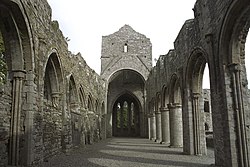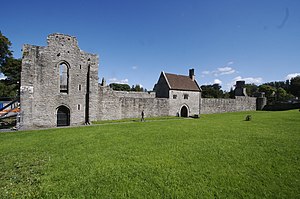Boyle Abbey
| Boyle Abbey | |
|
County Roscommon | |
|---|---|
 The nave of Boyle Abbey | |
| Location | |
| Grid reference: | G80570275 |
| Location: | 53°58’26"N, 8°17’49"W |
| Village: | Boyle |
| Order: | Cistercian |
| History | |
| Established: | 1218 |
| Founder: | Mac Diarmada family |
| Disestablished: | 1592 |
| Information | |
| Owned by: | Heritage Ireland |
| Website: | Boyle Abbey |
Boyle Abbey was a monastery in County Roscommon, whose ruins stand in the village of Boyle. This was the first successful foundation in Connaught of the Cistercian order which had opened its first Irish house at Mellifont, County Louth, in 1142.
Contents
History
In the 12th century Malachy of Armagh (known to later ages as St Malachy) became aware of two new monastic orders in France, the Cistercians and the Cannons Regular of St Augustine and he decided to introduce both orders to Ireland in an effort to reform the old Irish church which, both morally and organizationally, had fallen out of line with much of the rest of Christian Europe.
The first Cistercian Abbey was founded at Mellifont, County Louth in 1142. St Malachy made arrangements that young aspirant Irish men who want to become Cistercians should be trained in St. Bernard’s own monastery of Clairvaux or one of its daughter houses.
The Cistercians were invited to found an abbey in Moylurg as a daughter house of Mellifont. In 1148 Peter O’Mordha and twelve companions were sent to Connaught.[1] They tried Grellachdinach, Buniffi and Drumcunny before settling at Boyle. The monks being vegetarian required an amount of arable land adjacent to a monastery as well as the facility to be able to channel running water to the establishment. They were offered the Celtic monastery called Eas Mic NEirc or Assylin near a major river crossing called of Ath-Da-Larg or ‘the ford with two forks’, where roads leading north, south, east and west all converged. This monastery had either very few monks or none at all. Little is known of this monastery, beyond two references in the various annals and a visit by Saint Columba in 560.[2] McGreevy, a local chieftain, negotiated and gave this Celtic monastery in "pure free and perpetual alms" (which is to say with no strings attached) to the Cistercians. Documentary evidence shows that the McGreevys were still in this district one hundred years later, around 1258.
The Cistercians over many years after the foundation were given land grants of about 50,000 acres scattered west of the River Shannon in 27 out-farms called granges. The Cistercians however found the site of Assylin unsuitable owing to its geography, it is a height above the river, and eventually built on the present site a few miles to the east which was more conducive to their plans which dictated that running water should be on the site for cooking, washing and toilet requirements. It was also more suitable for essential ancillary facilities such as mills and fish ponds, one of which existed until relatively recent times.
The monastery prospered in the initial period, they made two foundations at Abbeyknockmoy in Galway and Assaroe in Donegal. It had been raised to the status of Abbey by 1174. [3] However the abbey buildings took much time and were not completed until ca. 1218 when the abbey was consecrated. This was due in part to the events of 1202 when during a war initiated over the succession to the kingship of Connaught, the abbey was occupied and very badly damaged. The evidence for this may be seen in the architecture, with differing styles in various parts of the church. The history continued to be full of incident, in the 1220s Boyle became involved in what was termed ‘The Conspiracy of Mellifont’ when that abbey and its various daughter houses attempted to break away from Norman control.[4] After that was resolved the abbey was attacked on a number of occasions such as 1235 [5] and 1284 [6]. However with the advent of the various orders of friars in Ireland, the Franciscans, Dominicans and Augustinians and others, who offered a different style of life, more in keeping with the local culture, the numbers of lay brothers, who worked the granges, declined and this resulted in many of the granges being leased out. The life of the abbey seems to have gone on as normal, in the late 13th and early 14th century its abbots were regularly made bishops of Elphin. However, by the end of the 15th century the family of the local chieftains appear to have taken control of the abbey, one of their number regularly becoming abbot. [7]
When the abbey was suppressed under Queen Elizabeth and the remaining assets given away, the new owner allowed the Cistercians to remain. The last abbot, Gelasius O’Cullenan ('Galisne O’Cuilleanain'), was executed in Dublin in 1584.
The monastery was laid out according to the usual Cistercian plan, a church on the north side of a roughly rectangular cloister area, with a chapter house for meetings of the monks on a second side, a kitchen and a refectory on the third, and probably store houses and dormitory above on the fourth.
Only small parts of the cloister survive, because it was turned into a barracks by the Elizabethans in 1592, and the Cromwellians who besieged it in 1645. This, along with possible later stone quarrying, ensured that little survives. Despite this, the ruins are impressive, dominated by a squat square tower that was added above the crossing sometime in the thirteenth century. The church adheres to the Cistercian canon in having a nave with side aisles, a transept to the north and south of the crossing, each with a pair of chapels in the east wall, and a chancel, whose original windows were replaced in the thirteenth century. The design was influenced by styles from Burgundy, whence the Cistercians came to Ireland, but much of the detailing of the nave and particularly the cylindrical piers of the south arcade has strong echoes of the western counties of England. The decorated corbels and capitals belonging to them were probably carved by local masons, some of them members of the so-called ‘School of the West’, creating some of the most inventive architectural sculpture of the early thirteenth century in the West of Ireland.
Today
The Abbey is now a national monument in state care, with paid admission for visitors.
A small piece of stone from the Abbey was carried to the other side of the world. Being placed on the monumental headstone of an Irishman Bartholomew Higgins in the Rookwood Necropolis Sydney Australia.
Outside links
- Boyle Abbey: Heritage Ireland
References
- Annals of Boyle
- Adammnan, Life of Columba.
- Annals of Lough Cé.
- O’Dwyer B W, Letters from Ireland 1228-1229 (Kalamazoo 1982).
- Annals of Connaught
- Annals of the Four Masters
- Hogan Flannan, Gelasius O’Cullenan O.Cist., Martyr—Abbot of Boyle, From Hallel, A Review of Monastic Spirituality and Liturgy.
- Sharkey P.A., The Heart of Ireland (Boyle 1927)
- Morgan Conal, The history of the Cistercian Abbey of Boyle, 1161-1584 (Roscommon Library 2017)
